Analysis of Change Management Strategies and Leadership at Captify
VerifiedAdded on 2021/02/20
|11
|3347
|19
Report
AI Summary
This report examines the impact of change on Captify, a UK-based advertising, digital entertainment, and marketing services company. It analyzes how changes in organizational strategy and operations, driven by internal and external factors, affect leadership, team behavior, and individual performance. The report details measures to mitigate the negative impacts of change, including forming potential teams, quick problem resolution, passionate and persuasive leadership, and fostering creative and innovative behavior. It also identifies barriers to change and their influence on leadership decision-making. Furthermore, the report explores different leadership approaches to effectively manage change within the organization. The assignment includes an analysis of how changes in supply chain management and debt recovery can positively impact the business. The report emphasizes the importance of formulating sound strategies to avoid negative impacts and highlights the role of an expert team in implementing changes considering all relevant factors.
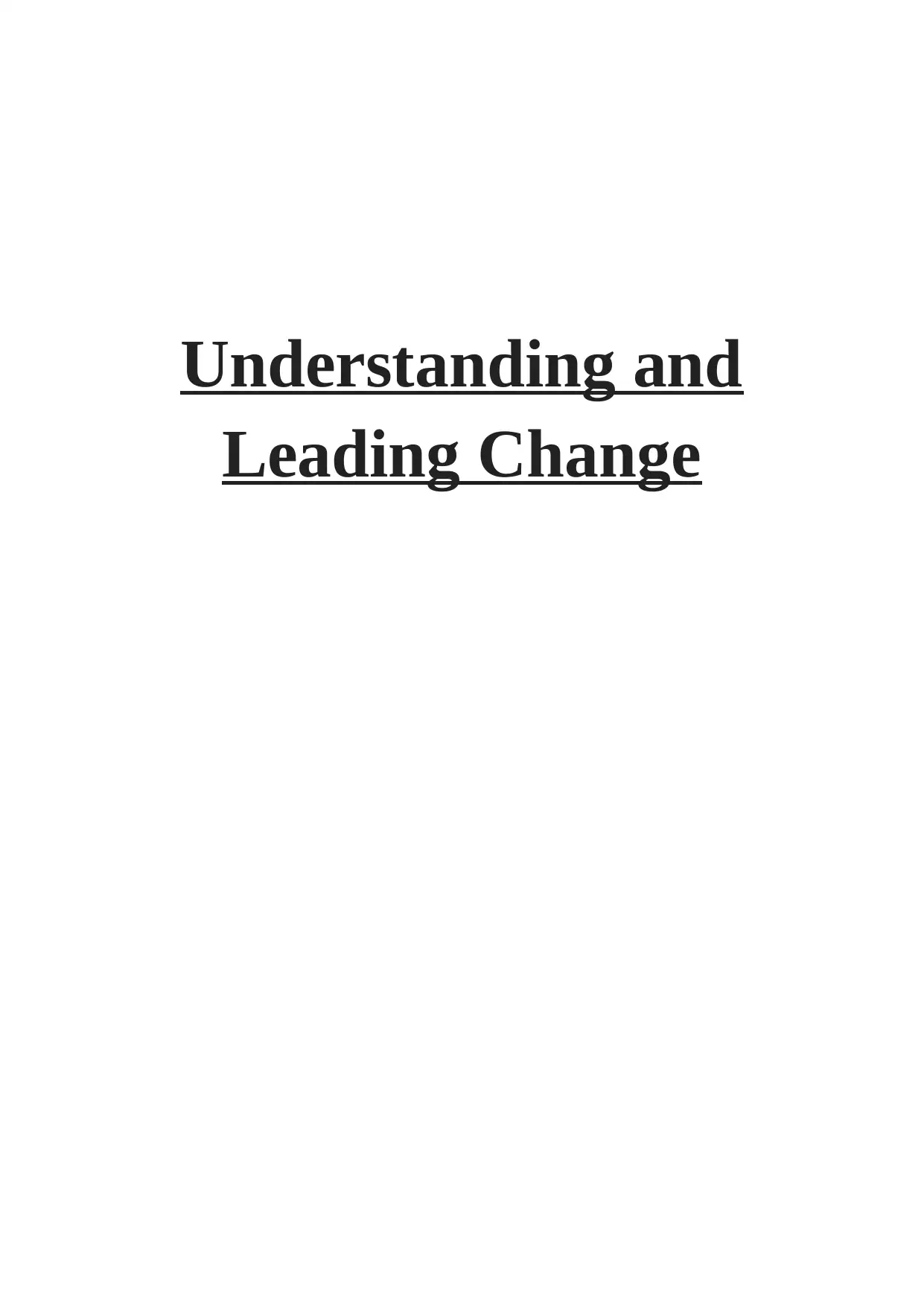
Understanding and
Leading Change
Leading Change
Paraphrase This Document
Need a fresh take? Get an instant paraphrase of this document with our AI Paraphraser
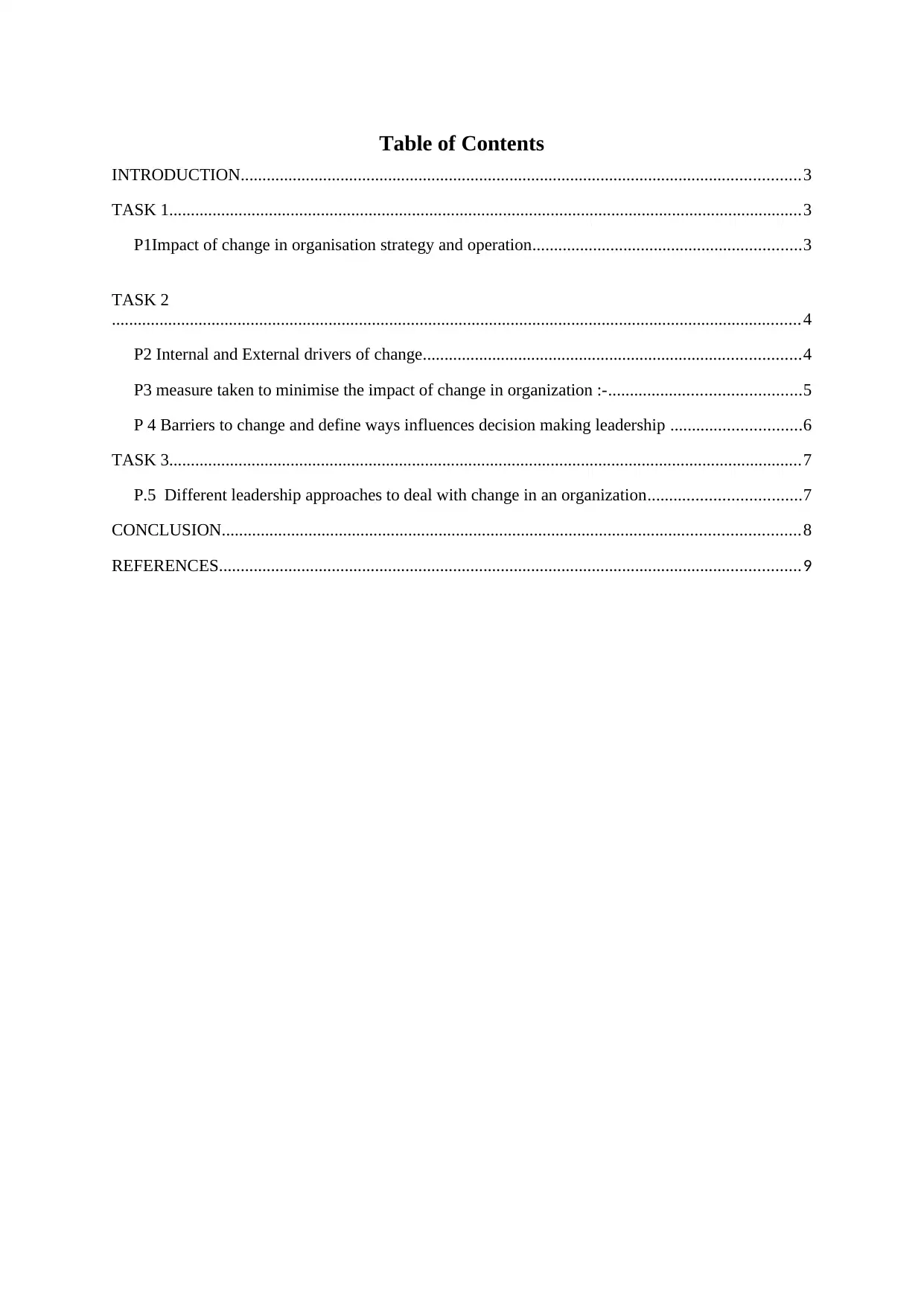
Table of Contents
INTRODUCTION.................................................................................................................................3
TASK 1..................................................................................................................................................3
P1Impact of change in organisation strategy and operation..............................................................3
TASK 2
...............................................................................................................................................................4
P2 Internal and External drivers of change.......................................................................................4
P3 measure taken to minimise the impact of change in organization :-............................................5
P 4 Barriers to change and define ways influences decision making leadership ..............................6
TASK 3..................................................................................................................................................7
P.5 Different leadership approaches to deal with change in an organization...................................7
CONCLUSION.....................................................................................................................................8
REFERENCES......................................................................................................................................9
INTRODUCTION.................................................................................................................................3
TASK 1..................................................................................................................................................3
P1Impact of change in organisation strategy and operation..............................................................3
TASK 2
...............................................................................................................................................................4
P2 Internal and External drivers of change.......................................................................................4
P3 measure taken to minimise the impact of change in organization :-............................................5
P 4 Barriers to change and define ways influences decision making leadership ..............................6
TASK 3..................................................................................................................................................7
P.5 Different leadership approaches to deal with change in an organization...................................7
CONCLUSION.....................................................................................................................................8
REFERENCES......................................................................................................................................9
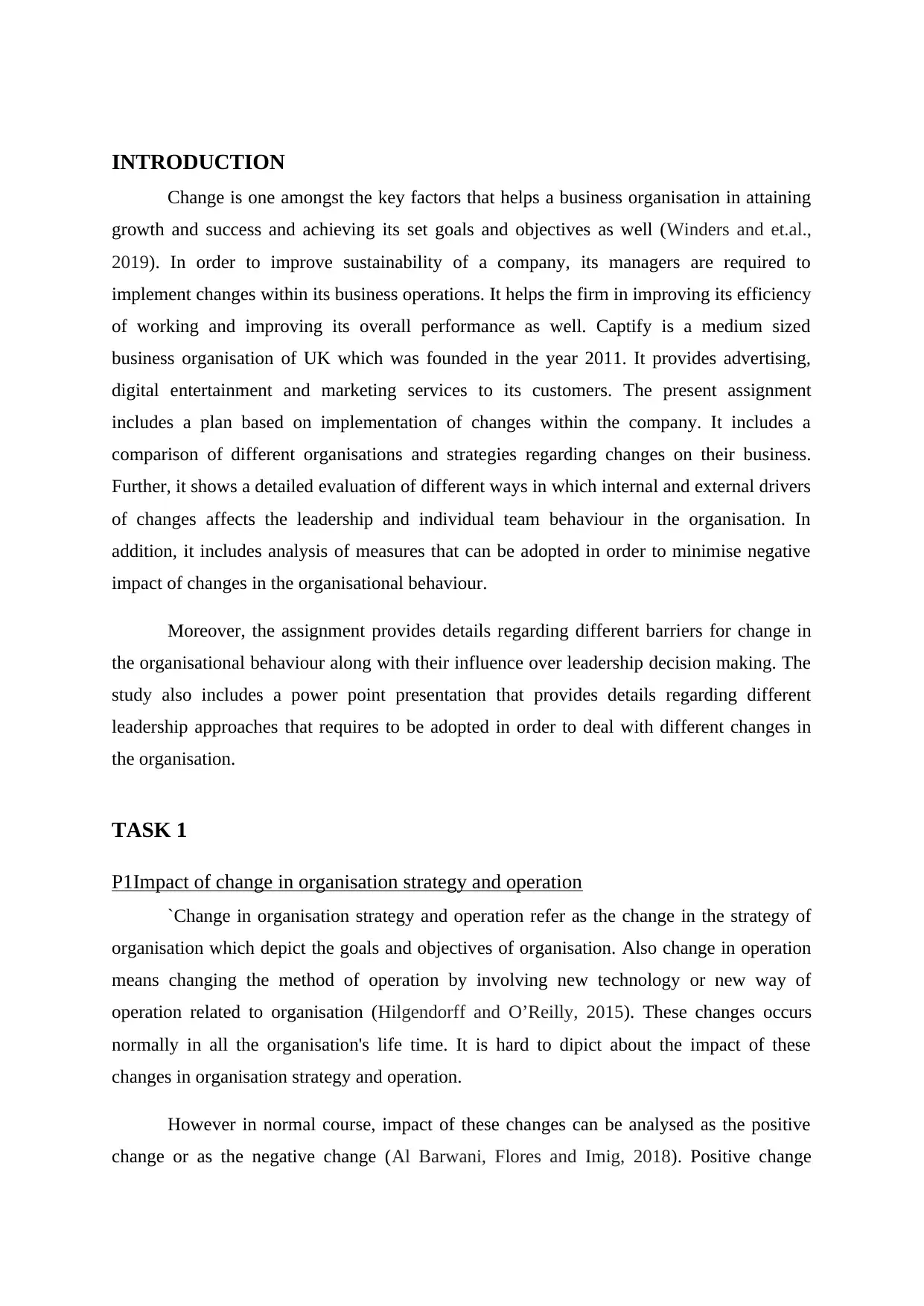
INTRODUCTION
Change is one amongst the key factors that helps a business organisation in attaining
growth and success and achieving its set goals and objectives as well (Winders and et.al.,
2019). In order to improve sustainability of a company, its managers are required to
implement changes within its business operations. It helps the firm in improving its efficiency
of working and improving its overall performance as well. Captify is a medium sized
business organisation of UK which was founded in the year 2011. It provides advertising,
digital entertainment and marketing services to its customers. The present assignment
includes a plan based on implementation of changes within the company. It includes a
comparison of different organisations and strategies regarding changes on their business.
Further, it shows a detailed evaluation of different ways in which internal and external drivers
of changes affects the leadership and individual team behaviour in the organisation. In
addition, it includes analysis of measures that can be adopted in order to minimise negative
impact of changes in the organisational behaviour.
Moreover, the assignment provides details regarding different barriers for change in
the organisational behaviour along with their influence over leadership decision making. The
study also includes a power point presentation that provides details regarding different
leadership approaches that requires to be adopted in order to deal with different changes in
the organisation.
TASK 1
P1Impact of change in organisation strategy and operation
`Change in organisation strategy and operation refer as the change in the strategy of
organisation which depict the goals and objectives of organisation. Also change in operation
means changing the method of operation by involving new technology or new way of
operation related to organisation (Hilgendorff and O’Reilly, 2015). These changes occurs
normally in all the organisation's life time. It is hard to dipict about the impact of these
changes in organisation strategy and operation.
However in normal course, impact of these changes can be analysed as the positive
change or as the negative change (Al Barwani, Flores and Imig, 2018). Positive change
Change is one amongst the key factors that helps a business organisation in attaining
growth and success and achieving its set goals and objectives as well (Winders and et.al.,
2019). In order to improve sustainability of a company, its managers are required to
implement changes within its business operations. It helps the firm in improving its efficiency
of working and improving its overall performance as well. Captify is a medium sized
business organisation of UK which was founded in the year 2011. It provides advertising,
digital entertainment and marketing services to its customers. The present assignment
includes a plan based on implementation of changes within the company. It includes a
comparison of different organisations and strategies regarding changes on their business.
Further, it shows a detailed evaluation of different ways in which internal and external drivers
of changes affects the leadership and individual team behaviour in the organisation. In
addition, it includes analysis of measures that can be adopted in order to minimise negative
impact of changes in the organisational behaviour.
Moreover, the assignment provides details regarding different barriers for change in
the organisational behaviour along with their influence over leadership decision making. The
study also includes a power point presentation that provides details regarding different
leadership approaches that requires to be adopted in order to deal with different changes in
the organisation.
TASK 1
P1Impact of change in organisation strategy and operation
`Change in organisation strategy and operation refer as the change in the strategy of
organisation which depict the goals and objectives of organisation. Also change in operation
means changing the method of operation by involving new technology or new way of
operation related to organisation (Hilgendorff and O’Reilly, 2015). These changes occurs
normally in all the organisation's life time. It is hard to dipict about the impact of these
changes in organisation strategy and operation.
However in normal course, impact of these changes can be analysed as the positive
change or as the negative change (Al Barwani, Flores and Imig, 2018). Positive change
⊘ This is a preview!⊘
Do you want full access?
Subscribe today to unlock all pages.

Trusted by 1+ million students worldwide
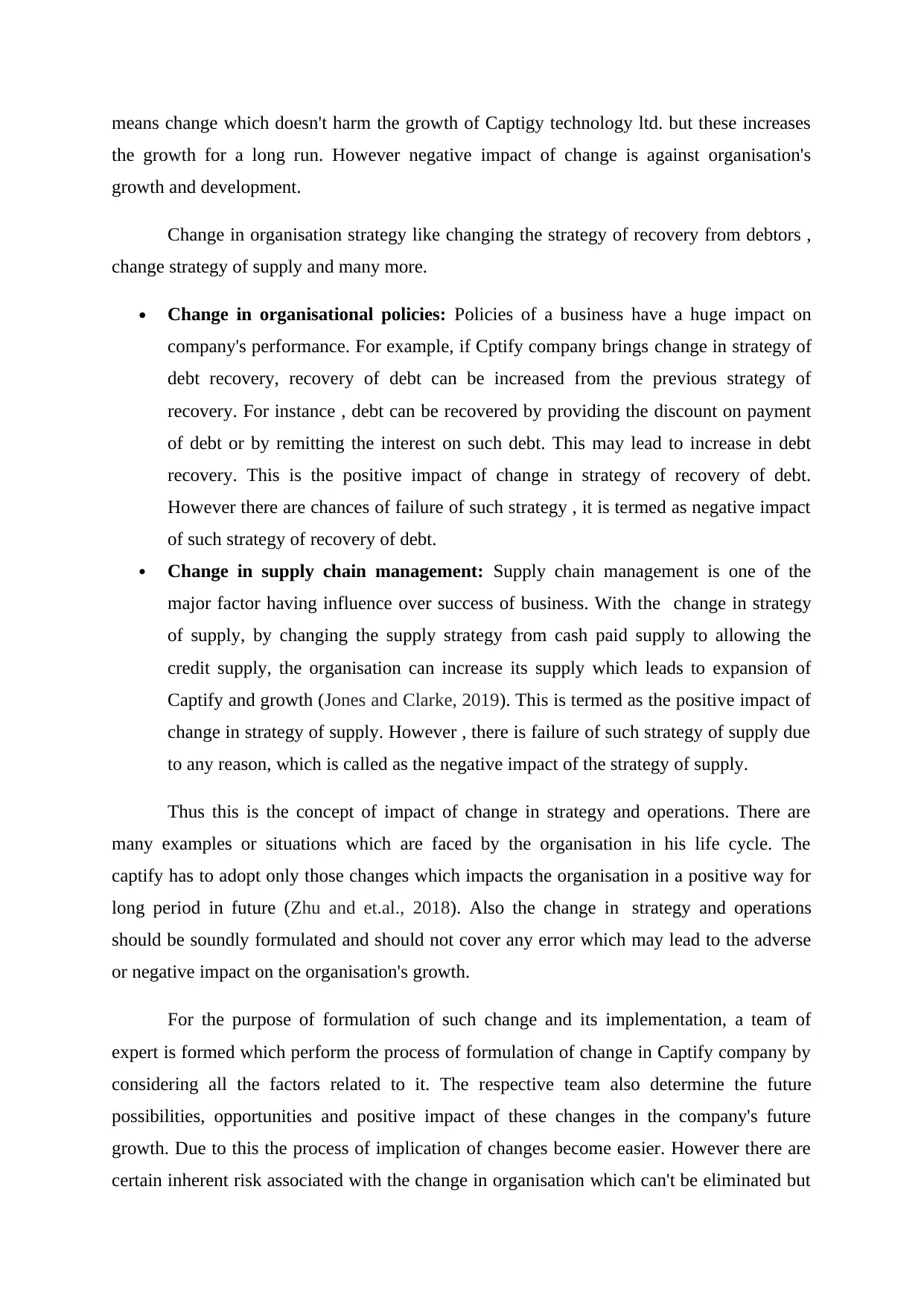
means change which doesn't harm the growth of Captigy technology ltd. but these increases
the growth for a long run. However negative impact of change is against organisation's
growth and development.
Change in organisation strategy like changing the strategy of recovery from debtors ,
change strategy of supply and many more.
Change in organisational policies: Policies of a business have a huge impact on
company's performance. For example, if Cptify company brings change in strategy of
debt recovery, recovery of debt can be increased from the previous strategy of
recovery. For instance , debt can be recovered by providing the discount on payment
of debt or by remitting the interest on such debt. This may lead to increase in debt
recovery. This is the positive impact of change in strategy of recovery of debt.
However there are chances of failure of such strategy , it is termed as negative impact
of such strategy of recovery of debt.
Change in supply chain management: Supply chain management is one of the
major factor having influence over success of business. With the change in strategy
of supply, by changing the supply strategy from cash paid supply to allowing the
credit supply, the organisation can increase its supply which leads to expansion of
Captify and growth (Jones and Clarke, 2019). This is termed as the positive impact of
change in strategy of supply. However , there is failure of such strategy of supply due
to any reason, which is called as the negative impact of the strategy of supply.
Thus this is the concept of impact of change in strategy and operations. There are
many examples or situations which are faced by the organisation in his life cycle. The
captify has to adopt only those changes which impacts the organisation in a positive way for
long period in future (Zhu and et.al., 2018). Also the change in strategy and operations
should be soundly formulated and should not cover any error which may lead to the adverse
or negative impact on the organisation's growth.
For the purpose of formulation of such change and its implementation, a team of
expert is formed which perform the process of formulation of change in Captify company by
considering all the factors related to it. The respective team also determine the future
possibilities, opportunities and positive impact of these changes in the company's future
growth. Due to this the process of implication of changes become easier. However there are
certain inherent risk associated with the change in organisation which can't be eliminated but
the growth for a long run. However negative impact of change is against organisation's
growth and development.
Change in organisation strategy like changing the strategy of recovery from debtors ,
change strategy of supply and many more.
Change in organisational policies: Policies of a business have a huge impact on
company's performance. For example, if Cptify company brings change in strategy of
debt recovery, recovery of debt can be increased from the previous strategy of
recovery. For instance , debt can be recovered by providing the discount on payment
of debt or by remitting the interest on such debt. This may lead to increase in debt
recovery. This is the positive impact of change in strategy of recovery of debt.
However there are chances of failure of such strategy , it is termed as negative impact
of such strategy of recovery of debt.
Change in supply chain management: Supply chain management is one of the
major factor having influence over success of business. With the change in strategy
of supply, by changing the supply strategy from cash paid supply to allowing the
credit supply, the organisation can increase its supply which leads to expansion of
Captify and growth (Jones and Clarke, 2019). This is termed as the positive impact of
change in strategy of supply. However , there is failure of such strategy of supply due
to any reason, which is called as the negative impact of the strategy of supply.
Thus this is the concept of impact of change in strategy and operations. There are
many examples or situations which are faced by the organisation in his life cycle. The
captify has to adopt only those changes which impacts the organisation in a positive way for
long period in future (Zhu and et.al., 2018). Also the change in strategy and operations
should be soundly formulated and should not cover any error which may lead to the adverse
or negative impact on the organisation's growth.
For the purpose of formulation of such change and its implementation, a team of
expert is formed which perform the process of formulation of change in Captify company by
considering all the factors related to it. The respective team also determine the future
possibilities, opportunities and positive impact of these changes in the company's future
growth. Due to this the process of implication of changes become easier. However there are
certain inherent risk associated with the change in organisation which can't be eliminated but
Paraphrase This Document
Need a fresh take? Get an instant paraphrase of this document with our AI Paraphraser
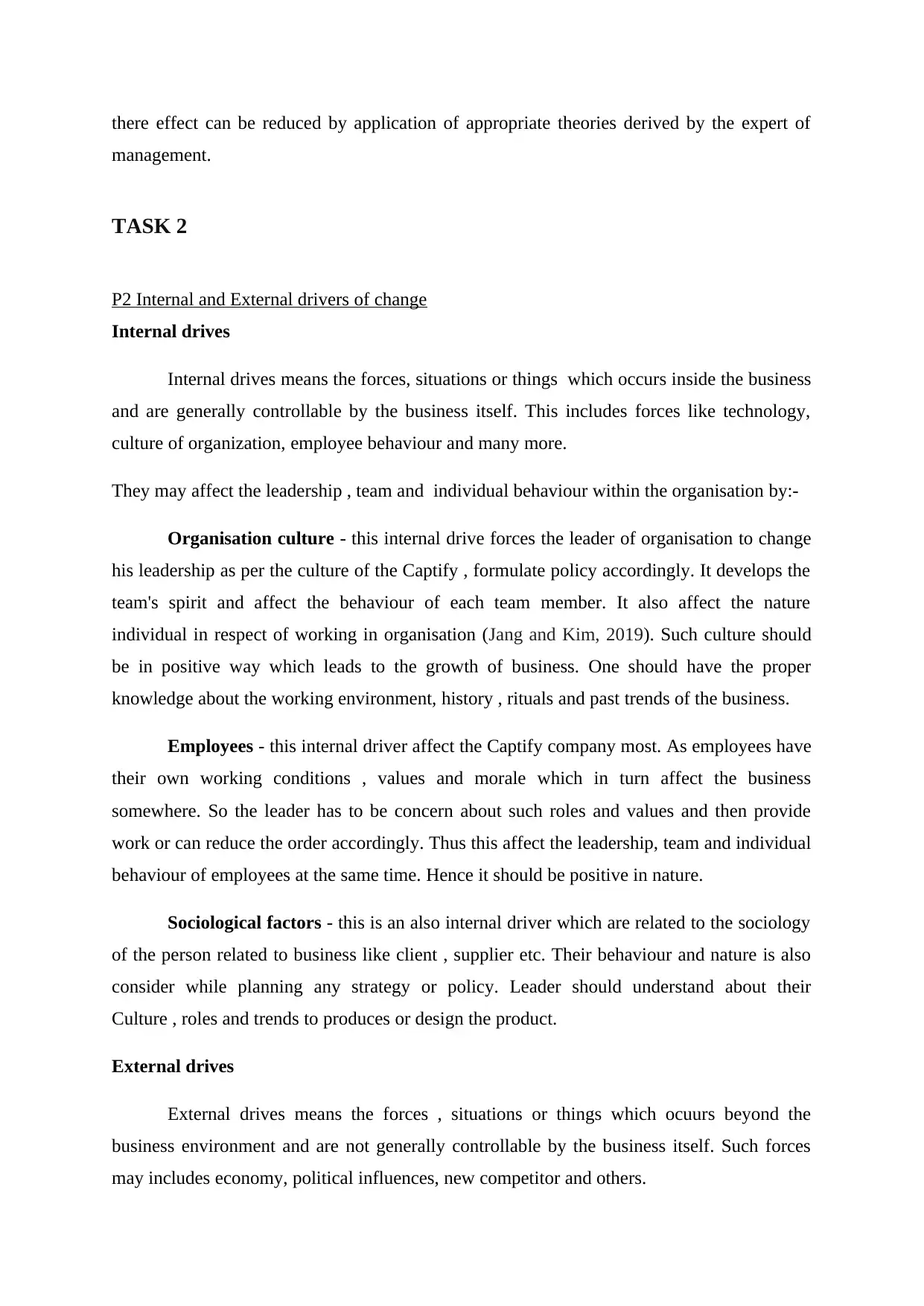
there effect can be reduced by application of appropriate theories derived by the expert of
management.
TASK 2
P2 Internal and External drivers of change
Internal drives
Internal drives means the forces, situations or things which occurs inside the business
and are generally controllable by the business itself. This includes forces like technology,
culture of organization, employee behaviour and many more.
They may affect the leadership , team and individual behaviour within the organisation by:-
Organisation culture - this internal drive forces the leader of organisation to change
his leadership as per the culture of the Captify , formulate policy accordingly. It develops the
team's spirit and affect the behaviour of each team member. It also affect the nature
individual in respect of working in organisation (Jang and Kim, 2019). Such culture should
be in positive way which leads to the growth of business. One should have the proper
knowledge about the working environment, history , rituals and past trends of the business.
Employees - this internal driver affect the Captify company most. As employees have
their own working conditions , values and morale which in turn affect the business
somewhere. So the leader has to be concern about such roles and values and then provide
work or can reduce the order accordingly. Thus this affect the leadership, team and individual
behaviour of employees at the same time. Hence it should be positive in nature.
Sociological factors - this is an also internal driver which are related to the sociology
of the person related to business like client , supplier etc. Their behaviour and nature is also
consider while planning any strategy or policy. Leader should understand about their
Culture , roles and trends to produces or design the product.
External drives
External drives means the forces , situations or things which ocuurs beyond the
business environment and are not generally controllable by the business itself. Such forces
may includes economy, political influences, new competitor and others.
management.
TASK 2
P2 Internal and External drivers of change
Internal drives
Internal drives means the forces, situations or things which occurs inside the business
and are generally controllable by the business itself. This includes forces like technology,
culture of organization, employee behaviour and many more.
They may affect the leadership , team and individual behaviour within the organisation by:-
Organisation culture - this internal drive forces the leader of organisation to change
his leadership as per the culture of the Captify , formulate policy accordingly. It develops the
team's spirit and affect the behaviour of each team member. It also affect the nature
individual in respect of working in organisation (Jang and Kim, 2019). Such culture should
be in positive way which leads to the growth of business. One should have the proper
knowledge about the working environment, history , rituals and past trends of the business.
Employees - this internal driver affect the Captify company most. As employees have
their own working conditions , values and morale which in turn affect the business
somewhere. So the leader has to be concern about such roles and values and then provide
work or can reduce the order accordingly. Thus this affect the leadership, team and individual
behaviour of employees at the same time. Hence it should be positive in nature.
Sociological factors - this is an also internal driver which are related to the sociology
of the person related to business like client , supplier etc. Their behaviour and nature is also
consider while planning any strategy or policy. Leader should understand about their
Culture , roles and trends to produces or design the product.
External drives
External drives means the forces , situations or things which ocuurs beyond the
business environment and are not generally controllable by the business itself. Such forces
may includes economy, political influences, new competitor and others.
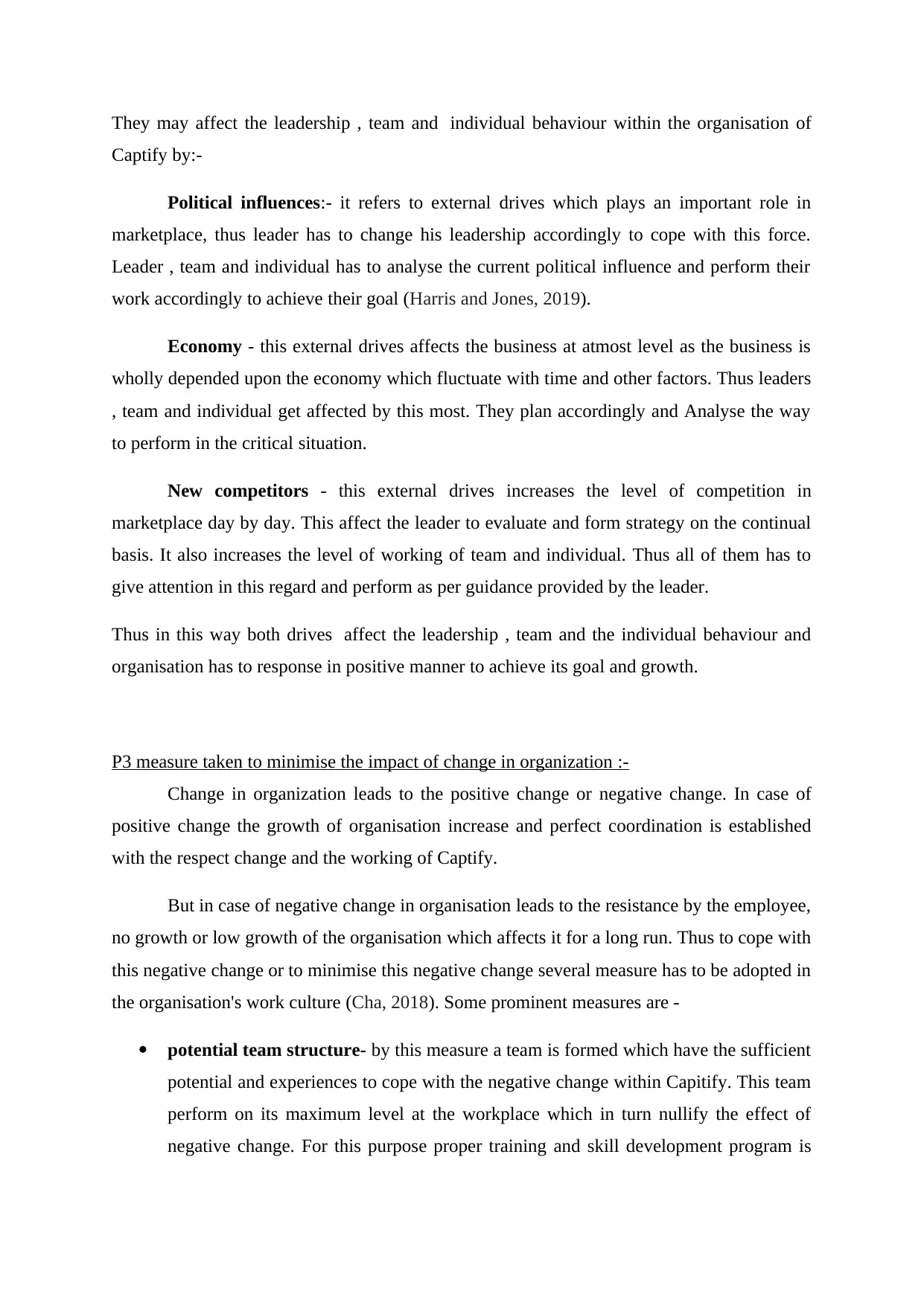
They may affect the leadership , team and individual behaviour within the organisation of
Captify by:-
Political influences:- it refers to external drives which plays an important role in
marketplace, thus leader has to change his leadership accordingly to cope with this force.
Leader , team and individual has to analyse the current political influence and perform their
work accordingly to achieve their goal (Harris and Jones, 2019).
Economy - this external drives affects the business at atmost level as the business is
wholly depended upon the economy which fluctuate with time and other factors. Thus leaders
, team and individual get affected by this most. They plan accordingly and Analyse the way
to perform in the critical situation.
New competitors - this external drives increases the level of competition in
marketplace day by day. This affect the leader to evaluate and form strategy on the continual
basis. It also increases the level of working of team and individual. Thus all of them has to
give attention in this regard and perform as per guidance provided by the leader.
Thus in this way both drives affect the leadership , team and the individual behaviour and
organisation has to response in positive manner to achieve its goal and growth.
P3 measure taken to minimise the impact of change in organization :-
Change in organization leads to the positive change or negative change. In case of
positive change the growth of organisation increase and perfect coordination is established
with the respect change and the working of Captify.
But in case of negative change in organisation leads to the resistance by the employee,
no growth or low growth of the organisation which affects it for a long run. Thus to cope with
this negative change or to minimise this negative change several measure has to be adopted in
the organisation's work culture (Cha, 2018). Some prominent measures are -
potential team structure- by this measure a team is formed which have the sufficient
potential and experiences to cope with the negative change within Capitify. This team
perform on its maximum level at the workplace which in turn nullify the effect of
negative change. For this purpose proper training and skill development program is
Captify by:-
Political influences:- it refers to external drives which plays an important role in
marketplace, thus leader has to change his leadership accordingly to cope with this force.
Leader , team and individual has to analyse the current political influence and perform their
work accordingly to achieve their goal (Harris and Jones, 2019).
Economy - this external drives affects the business at atmost level as the business is
wholly depended upon the economy which fluctuate with time and other factors. Thus leaders
, team and individual get affected by this most. They plan accordingly and Analyse the way
to perform in the critical situation.
New competitors - this external drives increases the level of competition in
marketplace day by day. This affect the leader to evaluate and form strategy on the continual
basis. It also increases the level of working of team and individual. Thus all of them has to
give attention in this regard and perform as per guidance provided by the leader.
Thus in this way both drives affect the leadership , team and the individual behaviour and
organisation has to response in positive manner to achieve its goal and growth.
P3 measure taken to minimise the impact of change in organization :-
Change in organization leads to the positive change or negative change. In case of
positive change the growth of organisation increase and perfect coordination is established
with the respect change and the working of Captify.
But in case of negative change in organisation leads to the resistance by the employee,
no growth or low growth of the organisation which affects it for a long run. Thus to cope with
this negative change or to minimise this negative change several measure has to be adopted in
the organisation's work culture (Cha, 2018). Some prominent measures are -
potential team structure- by this measure a team is formed which have the sufficient
potential and experiences to cope with the negative change within Capitify. This team
perform on its maximum level at the workplace which in turn nullify the effect of
negative change. For this purpose proper training and skill development program is
⊘ This is a preview!⊘
Do you want full access?
Subscribe today to unlock all pages.

Trusted by 1+ million students worldwide
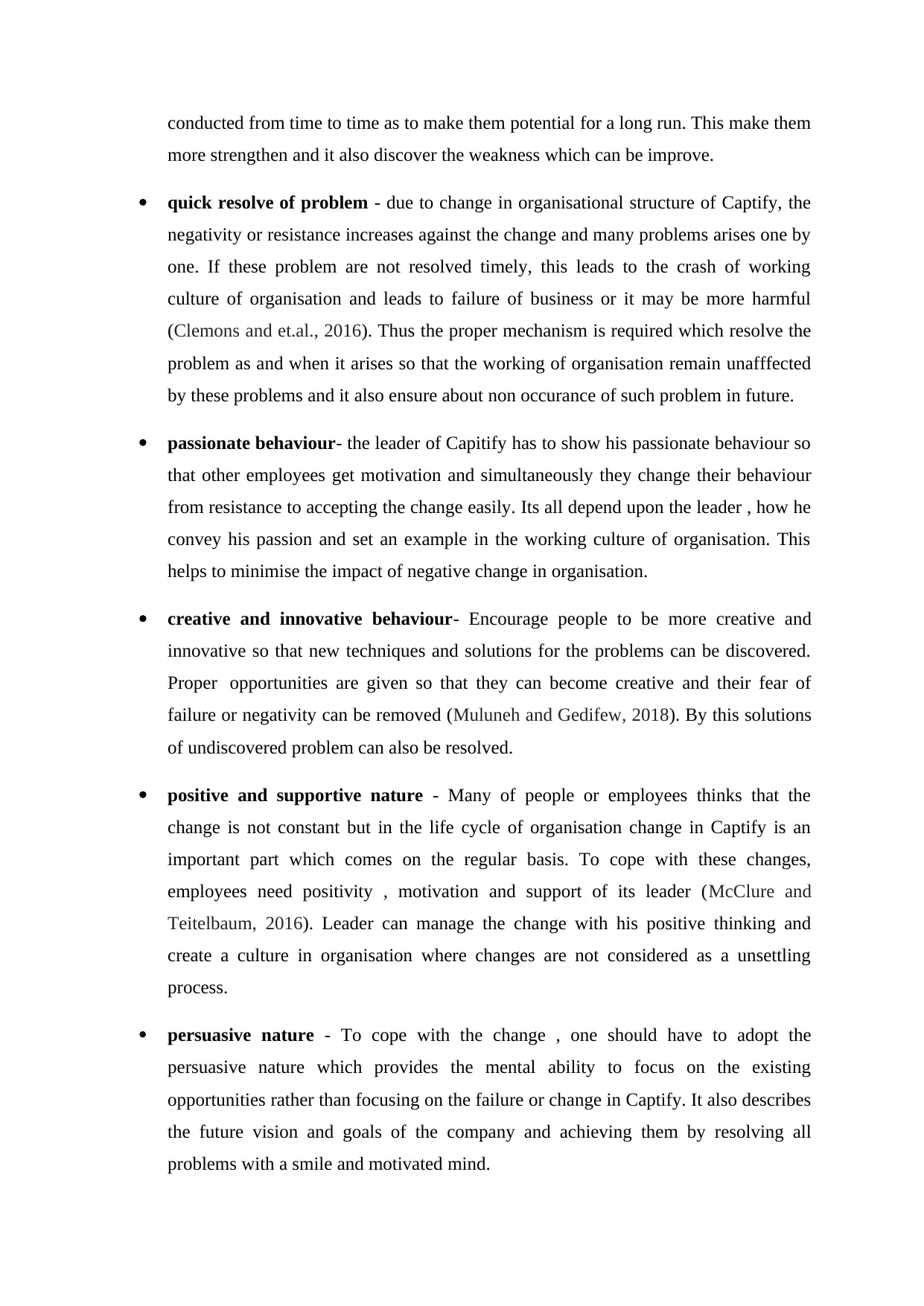
conducted from time to time as to make them potential for a long run. This make them
more strengthen and it also discover the weakness which can be improve.
quick resolve of problem - due to change in organisational structure of Captify, the
negativity or resistance increases against the change and many problems arises one by
one. If these problem are not resolved timely, this leads to the crash of working
culture of organisation and leads to failure of business or it may be more harmful
(Clemons and et.al., 2016). Thus the proper mechanism is required which resolve the
problem as and when it arises so that the working of organisation remain unafffected
by these problems and it also ensure about non occurance of such problem in future.
passionate behaviour- the leader of Capitify has to show his passionate behaviour so
that other employees get motivation and simultaneously they change their behaviour
from resistance to accepting the change easily. Its all depend upon the leader , how he
convey his passion and set an example in the working culture of organisation. This
helps to minimise the impact of negative change in organisation.
creative and innovative behaviour- Encourage people to be more creative and
innovative so that new techniques and solutions for the problems can be discovered.
Proper opportunities are given so that they can become creative and their fear of
failure or negativity can be removed (Muluneh and Gedifew, 2018). By this solutions
of undiscovered problem can also be resolved.
positive and supportive nature - Many of people or employees thinks that the
change is not constant but in the life cycle of organisation change in Captify is an
important part which comes on the regular basis. To cope with these changes,
employees need positivity , motivation and support of its leader (McClure and
Teitelbaum, 2016). Leader can manage the change with his positive thinking and
create a culture in organisation where changes are not considered as a unsettling
process.
persuasive nature - To cope with the change , one should have to adopt the
persuasive nature which provides the mental ability to focus on the existing
opportunities rather than focusing on the failure or change in Captify. It also describes
the future vision and goals of the company and achieving them by resolving all
problems with a smile and motivated mind.
more strengthen and it also discover the weakness which can be improve.
quick resolve of problem - due to change in organisational structure of Captify, the
negativity or resistance increases against the change and many problems arises one by
one. If these problem are not resolved timely, this leads to the crash of working
culture of organisation and leads to failure of business or it may be more harmful
(Clemons and et.al., 2016). Thus the proper mechanism is required which resolve the
problem as and when it arises so that the working of organisation remain unafffected
by these problems and it also ensure about non occurance of such problem in future.
passionate behaviour- the leader of Capitify has to show his passionate behaviour so
that other employees get motivation and simultaneously they change their behaviour
from resistance to accepting the change easily. Its all depend upon the leader , how he
convey his passion and set an example in the working culture of organisation. This
helps to minimise the impact of negative change in organisation.
creative and innovative behaviour- Encourage people to be more creative and
innovative so that new techniques and solutions for the problems can be discovered.
Proper opportunities are given so that they can become creative and their fear of
failure or negativity can be removed (Muluneh and Gedifew, 2018). By this solutions
of undiscovered problem can also be resolved.
positive and supportive nature - Many of people or employees thinks that the
change is not constant but in the life cycle of organisation change in Captify is an
important part which comes on the regular basis. To cope with these changes,
employees need positivity , motivation and support of its leader (McClure and
Teitelbaum, 2016). Leader can manage the change with his positive thinking and
create a culture in organisation where changes are not considered as a unsettling
process.
persuasive nature - To cope with the change , one should have to adopt the
persuasive nature which provides the mental ability to focus on the existing
opportunities rather than focusing on the failure or change in Captify. It also describes
the future vision and goals of the company and achieving them by resolving all
problems with a smile and motivated mind.
Paraphrase This Document
Need a fresh take? Get an instant paraphrase of this document with our AI Paraphraser
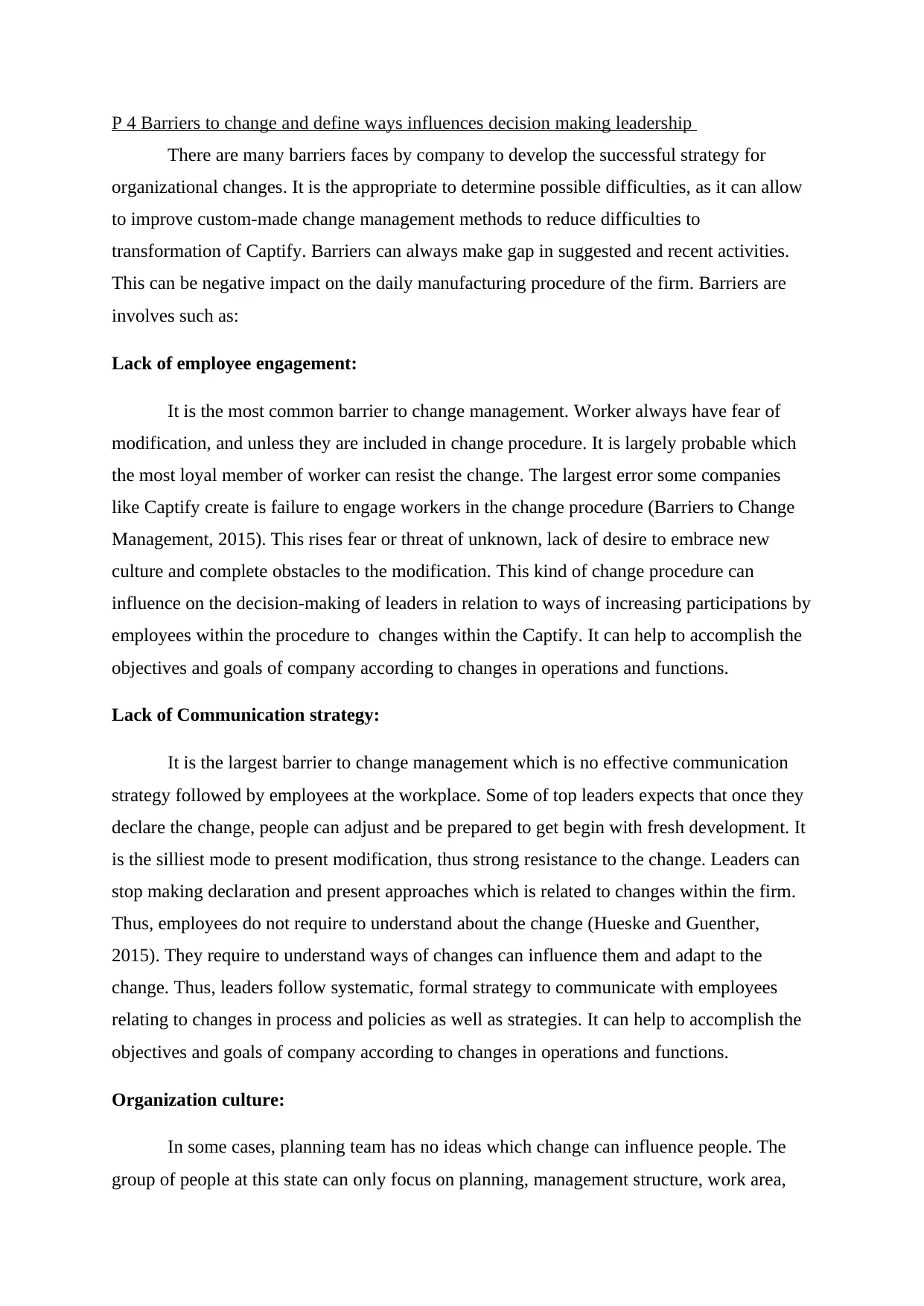
P 4 Barriers to change and define ways influences decision making leadership
There are many barriers faces by company to develop the successful strategy for
organizational changes. It is the appropriate to determine possible difficulties, as it can allow
to improve custom-made change management methods to reduce difficulties to
transformation of Captify. Barriers can always make gap in suggested and recent activities.
This can be negative impact on the daily manufacturing procedure of the firm. Barriers are
involves such as:
Lack of employee engagement:
It is the most common barrier to change management. Worker always have fear of
modification, and unless they are included in change procedure. It is largely probable which
the most loyal member of worker can resist the change. The largest error some companies
like Captify create is failure to engage workers in the change procedure (Barriers to Change
Management, 2015). This rises fear or threat of unknown, lack of desire to embrace new
culture and complete obstacles to the modification. This kind of change procedure can
influence on the decision-making of leaders in relation to ways of increasing participations by
employees within the procedure to changes within the Captify. It can help to accomplish the
objectives and goals of company according to changes in operations and functions.
Lack of Communication strategy:
It is the largest barrier to change management which is no effective communication
strategy followed by employees at the workplace. Some of top leaders expects that once they
declare the change, people can adjust and be prepared to get begin with fresh development. It
is the silliest mode to present modification, thus strong resistance to the change. Leaders can
stop making declaration and present approaches which is related to changes within the firm.
Thus, employees do not require to understand about the change (Hueske and Guenther,
2015). They require to understand ways of changes can influence them and adapt to the
change. Thus, leaders follow systematic, formal strategy to communicate with employees
relating to changes in process and policies as well as strategies. It can help to accomplish the
objectives and goals of company according to changes in operations and functions.
Organization culture:
In some cases, planning team has no ideas which change can influence people. The
group of people at this state can only focus on planning, management structure, work area,
There are many barriers faces by company to develop the successful strategy for
organizational changes. It is the appropriate to determine possible difficulties, as it can allow
to improve custom-made change management methods to reduce difficulties to
transformation of Captify. Barriers can always make gap in suggested and recent activities.
This can be negative impact on the daily manufacturing procedure of the firm. Barriers are
involves such as:
Lack of employee engagement:
It is the most common barrier to change management. Worker always have fear of
modification, and unless they are included in change procedure. It is largely probable which
the most loyal member of worker can resist the change. The largest error some companies
like Captify create is failure to engage workers in the change procedure (Barriers to Change
Management, 2015). This rises fear or threat of unknown, lack of desire to embrace new
culture and complete obstacles to the modification. This kind of change procedure can
influence on the decision-making of leaders in relation to ways of increasing participations by
employees within the procedure to changes within the Captify. It can help to accomplish the
objectives and goals of company according to changes in operations and functions.
Lack of Communication strategy:
It is the largest barrier to change management which is no effective communication
strategy followed by employees at the workplace. Some of top leaders expects that once they
declare the change, people can adjust and be prepared to get begin with fresh development. It
is the silliest mode to present modification, thus strong resistance to the change. Leaders can
stop making declaration and present approaches which is related to changes within the firm.
Thus, employees do not require to understand about the change (Hueske and Guenther,
2015). They require to understand ways of changes can influence them and adapt to the
change. Thus, leaders follow systematic, formal strategy to communicate with employees
relating to changes in process and policies as well as strategies. It can help to accomplish the
objectives and goals of company according to changes in operations and functions.
Organization culture:
In some cases, planning team has no ideas which change can influence people. The
group of people at this state can only focus on planning, management structure, work area,
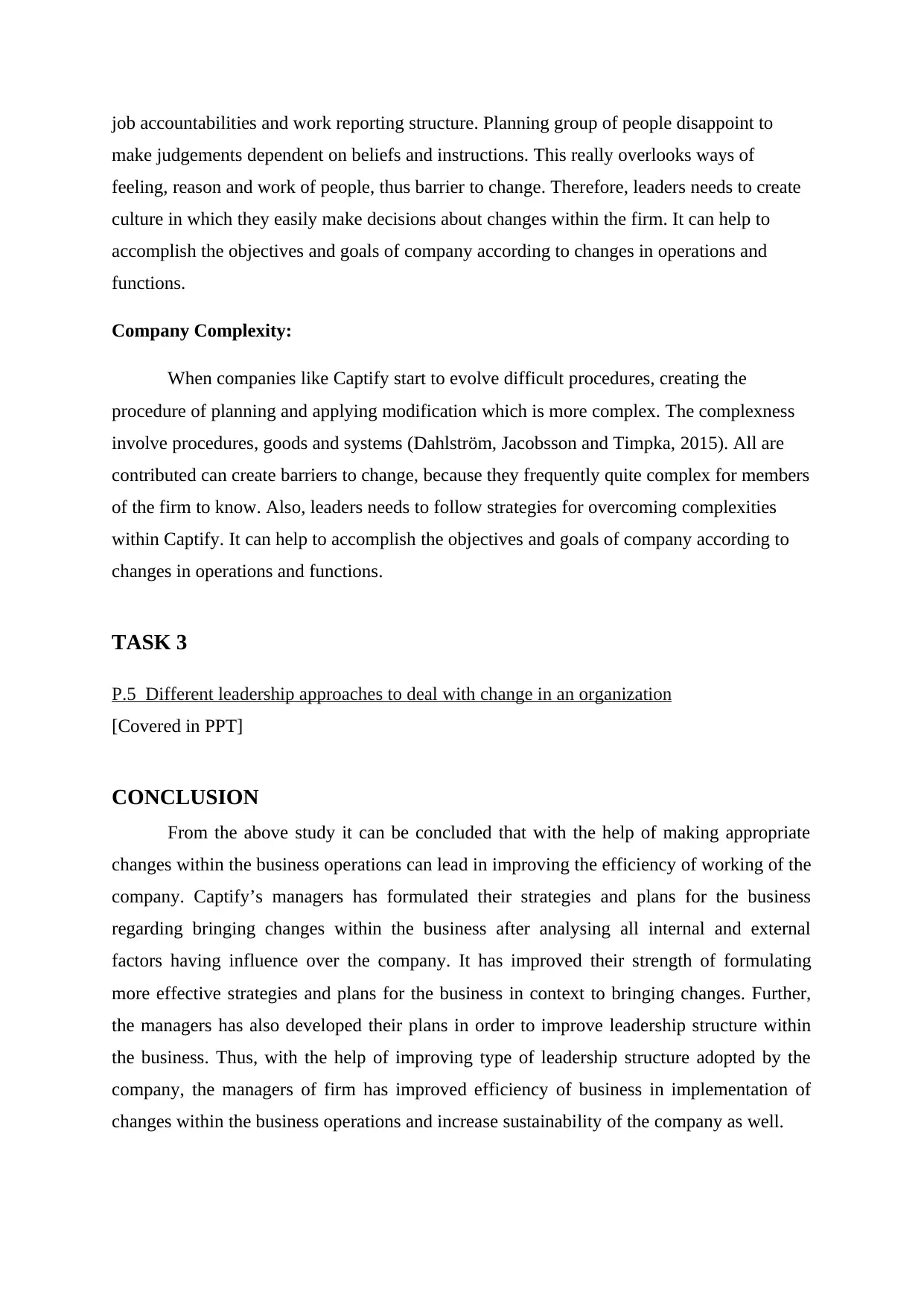
job accountabilities and work reporting structure. Planning group of people disappoint to
make judgements dependent on beliefs and instructions. This really overlooks ways of
feeling, reason and work of people, thus barrier to change. Therefore, leaders needs to create
culture in which they easily make decisions about changes within the firm. It can help to
accomplish the objectives and goals of company according to changes in operations and
functions.
Company Complexity:
When companies like Captify start to evolve difficult procedures, creating the
procedure of planning and applying modification which is more complex. The complexness
involve procedures, goods and systems (Dahlström, Jacobsson and Timpka, 2015). All are
contributed can create barriers to change, because they frequently quite complex for members
of the firm to know. Also, leaders needs to follow strategies for overcoming complexities
within Captify. It can help to accomplish the objectives and goals of company according to
changes in operations and functions.
TASK 3
P.5 Different leadership approaches to deal with change in an organization
[Covered in PPT]
CONCLUSION
From the above study it can be concluded that with the help of making appropriate
changes within the business operations can lead in improving the efficiency of working of the
company. Captify’s managers has formulated their strategies and plans for the business
regarding bringing changes within the business after analysing all internal and external
factors having influence over the company. It has improved their strength of formulating
more effective strategies and plans for the business in context to bringing changes. Further,
the managers has also developed their plans in order to improve leadership structure within
the business. Thus, with the help of improving type of leadership structure adopted by the
company, the managers of firm has improved efficiency of business in implementation of
changes within the business operations and increase sustainability of the company as well.
make judgements dependent on beliefs and instructions. This really overlooks ways of
feeling, reason and work of people, thus barrier to change. Therefore, leaders needs to create
culture in which they easily make decisions about changes within the firm. It can help to
accomplish the objectives and goals of company according to changes in operations and
functions.
Company Complexity:
When companies like Captify start to evolve difficult procedures, creating the
procedure of planning and applying modification which is more complex. The complexness
involve procedures, goods and systems (Dahlström, Jacobsson and Timpka, 2015). All are
contributed can create barriers to change, because they frequently quite complex for members
of the firm to know. Also, leaders needs to follow strategies for overcoming complexities
within Captify. It can help to accomplish the objectives and goals of company according to
changes in operations and functions.
TASK 3
P.5 Different leadership approaches to deal with change in an organization
[Covered in PPT]
CONCLUSION
From the above study it can be concluded that with the help of making appropriate
changes within the business operations can lead in improving the efficiency of working of the
company. Captify’s managers has formulated their strategies and plans for the business
regarding bringing changes within the business after analysing all internal and external
factors having influence over the company. It has improved their strength of formulating
more effective strategies and plans for the business in context to bringing changes. Further,
the managers has also developed their plans in order to improve leadership structure within
the business. Thus, with the help of improving type of leadership structure adopted by the
company, the managers of firm has improved efficiency of business in implementation of
changes within the business operations and increase sustainability of the company as well.
⊘ This is a preview!⊘
Do you want full access?
Subscribe today to unlock all pages.

Trusted by 1+ million students worldwide
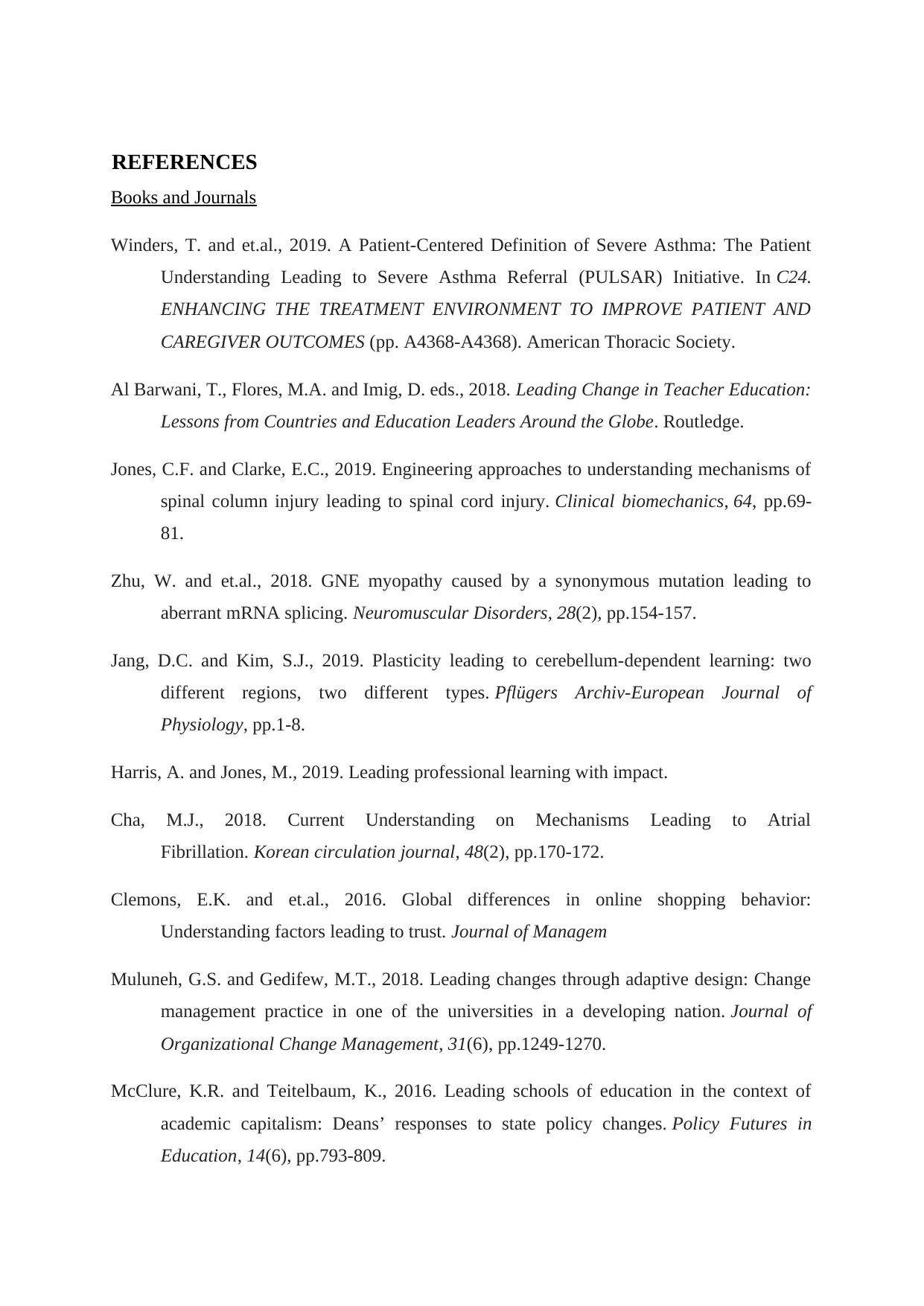
REFERENCES
Books and Journals
Winders, T. and et.al., 2019. A Patient-Centered Definition of Severe Asthma: The Patient
Understanding Leading to Severe Asthma Referral (PULSAR) Initiative. In C24.
ENHANCING THE TREATMENT ENVIRONMENT TO IMPROVE PATIENT AND
CAREGIVER OUTCOMES (pp. A4368-A4368). American Thoracic Society.
Al Barwani, T., Flores, M.A. and Imig, D. eds., 2018. Leading Change in Teacher Education:
Lessons from Countries and Education Leaders Around the Globe. Routledge.
Jones, C.F. and Clarke, E.C., 2019. Engineering approaches to understanding mechanisms of
spinal column injury leading to spinal cord injury. Clinical biomechanics, 64, pp.69-
81.
Zhu, W. and et.al., 2018. GNE myopathy caused by a synonymous mutation leading to
aberrant mRNA splicing. Neuromuscular Disorders, 28(2), pp.154-157.
Jang, D.C. and Kim, S.J., 2019. Plasticity leading to cerebellum-dependent learning: two
different regions, two different types. Pflügers Archiv-European Journal of
Physiology, pp.1-8.
Harris, A. and Jones, M., 2019. Leading professional learning with impact.
Cha, M.J., 2018. Current Understanding on Mechanisms Leading to Atrial
Fibrillation. Korean circulation journal, 48(2), pp.170-172.
Clemons, E.K. and et.al., 2016. Global differences in online shopping behavior:
Understanding factors leading to trust. Journal of Managem
Muluneh, G.S. and Gedifew, M.T., 2018. Leading changes through adaptive design: Change
management practice in one of the universities in a developing nation. Journal of
Organizational Change Management, 31(6), pp.1249-1270.
McClure, K.R. and Teitelbaum, K., 2016. Leading schools of education in the context of
academic capitalism: Deans’ responses to state policy changes. Policy Futures in
Education, 14(6), pp.793-809.
Books and Journals
Winders, T. and et.al., 2019. A Patient-Centered Definition of Severe Asthma: The Patient
Understanding Leading to Severe Asthma Referral (PULSAR) Initiative. In C24.
ENHANCING THE TREATMENT ENVIRONMENT TO IMPROVE PATIENT AND
CAREGIVER OUTCOMES (pp. A4368-A4368). American Thoracic Society.
Al Barwani, T., Flores, M.A. and Imig, D. eds., 2018. Leading Change in Teacher Education:
Lessons from Countries and Education Leaders Around the Globe. Routledge.
Jones, C.F. and Clarke, E.C., 2019. Engineering approaches to understanding mechanisms of
spinal column injury leading to spinal cord injury. Clinical biomechanics, 64, pp.69-
81.
Zhu, W. and et.al., 2018. GNE myopathy caused by a synonymous mutation leading to
aberrant mRNA splicing. Neuromuscular Disorders, 28(2), pp.154-157.
Jang, D.C. and Kim, S.J., 2019. Plasticity leading to cerebellum-dependent learning: two
different regions, two different types. Pflügers Archiv-European Journal of
Physiology, pp.1-8.
Harris, A. and Jones, M., 2019. Leading professional learning with impact.
Cha, M.J., 2018. Current Understanding on Mechanisms Leading to Atrial
Fibrillation. Korean circulation journal, 48(2), pp.170-172.
Clemons, E.K. and et.al., 2016. Global differences in online shopping behavior:
Understanding factors leading to trust. Journal of Managem
Muluneh, G.S. and Gedifew, M.T., 2018. Leading changes through adaptive design: Change
management practice in one of the universities in a developing nation. Journal of
Organizational Change Management, 31(6), pp.1249-1270.
McClure, K.R. and Teitelbaum, K., 2016. Leading schools of education in the context of
academic capitalism: Deans’ responses to state policy changes. Policy Futures in
Education, 14(6), pp.793-809.
Paraphrase This Document
Need a fresh take? Get an instant paraphrase of this document with our AI Paraphraser
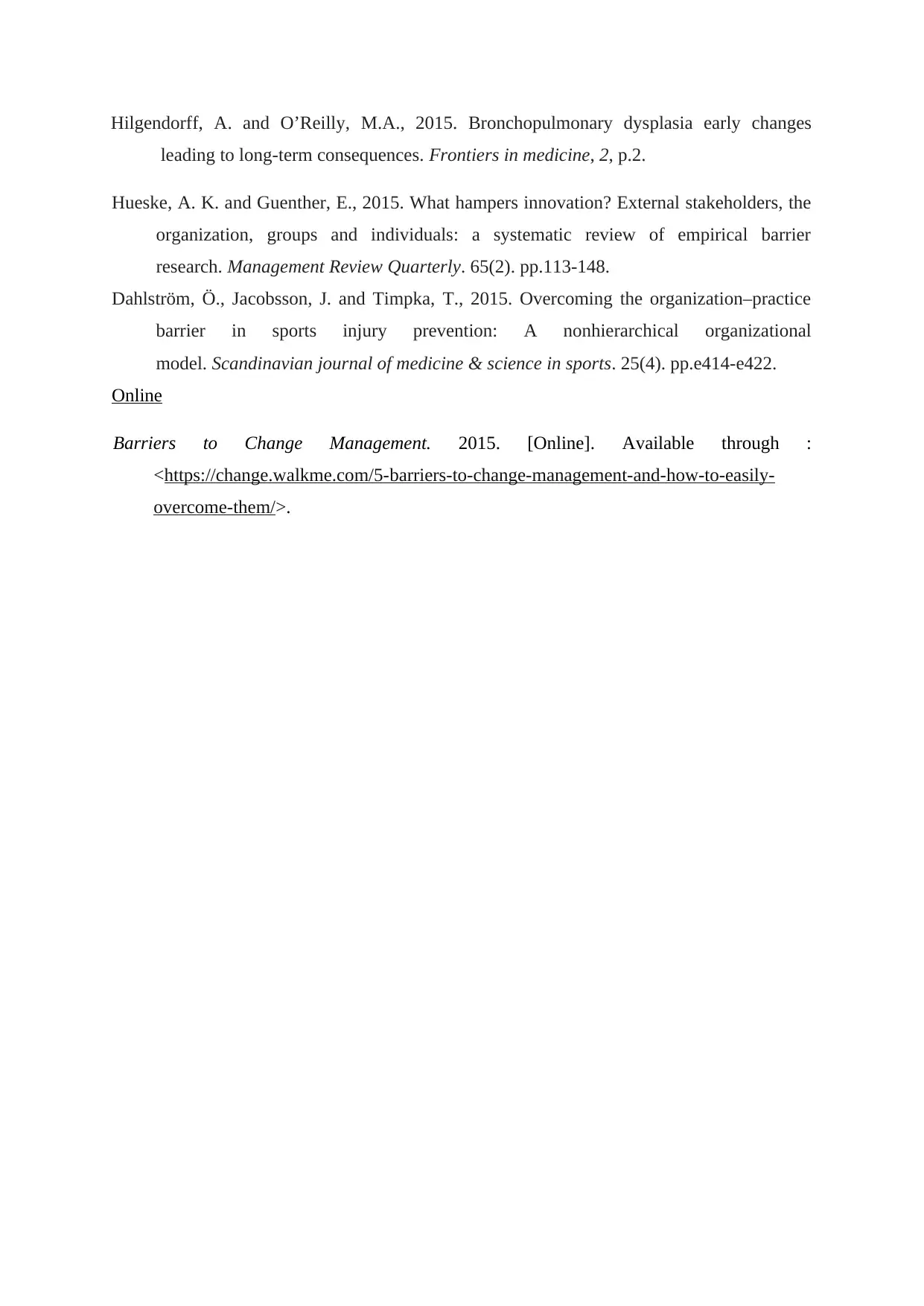
Hilgendorff, A. and O’Reilly, M.A., 2015. Bronchopulmonary dysplasia early changes
leading to long-term consequences. Frontiers in medicine, 2, p.2.
Hueske, A. K. and Guenther, E., 2015. What hampers innovation? External stakeholders, the
organization, groups and individuals: a systematic review of empirical barrier
research. Management Review Quarterly. 65(2). pp.113-148.
Dahlström, Ö., Jacobsson, J. and Timpka, T., 2015. Overcoming the organization–practice
barrier in sports injury prevention: A nonhierarchical organizational
model. Scandinavian journal of medicine & science in sports. 25(4). pp.e414-e422.
Online
Barriers to Change Management. 2015. [Online]. Available through :
<https://change.walkme.com/5-barriers-to-change-management-and-how-to-easily-
overcome-them/>.
leading to long-term consequences. Frontiers in medicine, 2, p.2.
Hueske, A. K. and Guenther, E., 2015. What hampers innovation? External stakeholders, the
organization, groups and individuals: a systematic review of empirical barrier
research. Management Review Quarterly. 65(2). pp.113-148.
Dahlström, Ö., Jacobsson, J. and Timpka, T., 2015. Overcoming the organization–practice
barrier in sports injury prevention: A nonhierarchical organizational
model. Scandinavian journal of medicine & science in sports. 25(4). pp.e414-e422.
Online
Barriers to Change Management. 2015. [Online]. Available through :
<https://change.walkme.com/5-barriers-to-change-management-and-how-to-easily-
overcome-them/>.
1 out of 11
Related Documents
Your All-in-One AI-Powered Toolkit for Academic Success.
+13062052269
info@desklib.com
Available 24*7 on WhatsApp / Email
![[object Object]](/_next/static/media/star-bottom.7253800d.svg)
Unlock your academic potential
Copyright © 2020–2025 A2Z Services. All Rights Reserved. Developed and managed by ZUCOL.





